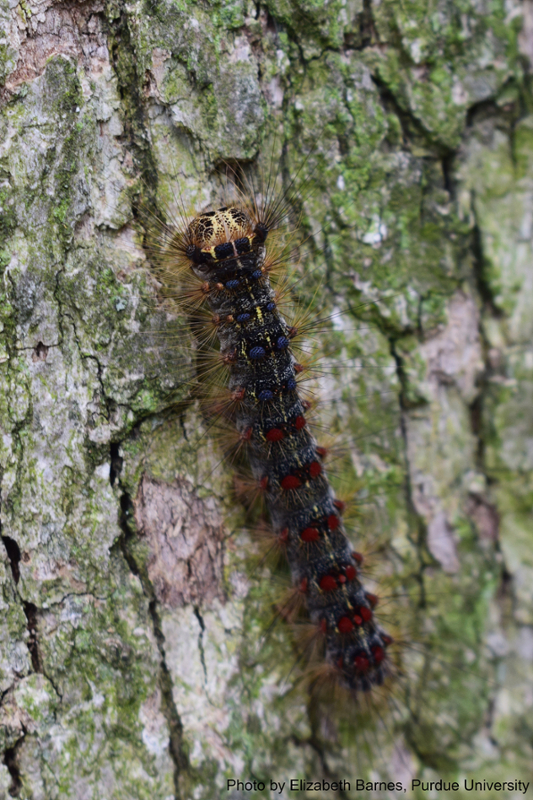Spongy Moth – New Name, Same Serious Threat
The recently renamed spongy moth, Lymantria dispar, formerly known as the gypsy moth, remains a real threat to hardwoods in northern and northeastern Indiana.
Purdue Extension has a website dedicated to information about this pest at https://ag.purdue.edu/department/entm/extension/spongy-moth/. Some of the information I’ll share is sourced from that website.
The spongy moth is the most serious forest defoliator in the United States. Trees in northern and northeastern Indiana are most commonly affected. Oak leaves are their preferred food, but spongy moth caterpillars can eat the foliage of 500 species of trees and plants. While most trees will produce new leaves after defoliation, repeated annual defoliation may kill trees in two to four years. Whitley County was added to quarantined counties for the spongy moth in 2023 to limit the artificial spread to other areas and remains in quarantine.
Spongy moths are not native to the United States. Since their accidental introduction to Massachusetts in 1869, they have spread steadily westward. In 1998 spongy moth became established in Steuben County, Indiana. Indiana Department of Natural Resources (DNR) monitors for spongy moth, and in 2023, they caught 1642 moths in their Whitley County traps, a high number. Other northern Indiana counties ranged from around 1000 to nearly 6000 catches in 2023.
Spongy moth caterpillars hatch in early spring, usually in mid to late April when the eastern redbuds bloom. The quarter-inch-long larvae easily go unnoticed. They spend about 40 days as caterpillars and generally reach their full size of 1.5-2 inches in mid-May to early June. In mid-June, they pupate for about 10-14 days and emerge as adults in early July. The adult moths mate and females lay their eggs from July to August on just about anything they can find. Each egg mass can contain anywhere from 500 to 1,000 eggs, and they overwinter in this egg mass. You can help slow their spread by inspecting your vehicles, trailers, and anything else kept outside before you travel.
Spongy moth caterpillars are hungry! Each caterpillar can consume a square yard of leaves during its lifetime, which lets them easily defoliate a tree during an outbreak.
Spongy moth caterpillars prefer oaks, but will also eat willow, sweetgum, poplar, apple, pine, and over 500 other species of plants. They will move on to other tree species if they run out of preferred leaves. They do not like ash, tuliptree, black locust, or black walnut.
Outbreaks of spongy moths can cause serious ecological and economic harm, but there are ways to reduce their impact. Managing outbreaks, slowing their spread, and reporting new populations can help protect our communities from this insect.
Yearly, Indiana DNR targets certain problem areas in which to spray control products and slow the spread of this pest. In 2024, the plan includes the use of a mating disruption product in extreme northeastern Huntington County, including small parts of southeastern Whitley County and southwestern Allen County. Find more information at https://www.in.gov/dnr/entomology/regulatory-information/spongy-moth/.
Find more information and possible management suggestions for homeowners and woodland owners in the Purdue Extension publication, The Spongy Moth in Indiana, available at https://extension.entm.purdue.edu/publications/GM-1/GM-1.html.

Spongy moth caterpillar. Photo by Elizabeth Barnes, Purdue University.
